Spatial-Temporal Analysis of PM2.5 and NO2 Concentrations Collected Using Low-Cost Sensors in Peñuelas, Puerto Rico †
Abstract
1. Introduction
2. Materials and Methods
2.1. Instrumentation
2.2. Deployment Area
2.3. Collocation Period
2.4. Data Analysis and Quality Assurance Procedures
3. Results
3.1. Meteorological Conditions
3.2. Long-Term CSAM Collocation
3.3. 1 h Average Pollutant Concentrations
3.4. Spatial Analysis of 1 h Average PM2.5 and NO2 Concentrations
3.5. Spatial Analysis of PM2.5 and NO2 Concentrations as a Function of Wind Conditions
3.6. Temporal Comparisons
4. Discussion
5. Conclusions
Author Contributions
Funding
Acknowledgments
Conflicts of Interest
References
- Snyder, E.G.; Watkins, T.H.; Solomon, P.A.; Thoma, E.D.; Williams, R.W.; Hagler, G.S.W.; Shelow, D.; Hindin, D.A.; Kilaru, V.J.; Preuss, P.W. The Changing Paradigm of Air Pollution Monitoring. Environ. Sci. Technol. 2013, 47, 11369–11377. [Google Scholar] [CrossRef] [PubMed]
- Kaufman, A.; Williams, R.; Barzyk, T.; Greenberg, M.; O’Shea, M.; Sheridan, P.; Hoang, A.; Ash, C.; Teitz, A.; Mustafa, M. A Citizen Science and Government Collaboration: Developing Tools to Facilitate Community Air Monitoring. Environ. Justice 2017, 10, 51–61. [Google Scholar] [CrossRef]
- Mijling, B.; Jiang, Q.; de Jonge, D.; Bocconi, S. Field calibration of electrochemical NO2 sensors in a citizen science context. Atmos. Meas. Tech. 2018, 11, 1297–1312. [Google Scholar] [CrossRef]
- Klepeis, N.E.; Bellettiere, J.; Hughes, S.C.; Nguyen, B.; Berardi, V.; Liles, S.; Obayashi, S.; Hofstetter, C.R.; Blumberg, E.; Hovell, M.F. Fine particles in homes of predominantly low-income families with children and smokers: Key physical and behavioral determinants to inform indoor-air-quality interventions. PLoS ONE 2017, 12, e0177718. [Google Scholar] [CrossRef]
- De Souza, P.; Nthusi, V.; Klopp, J.M.; Shaw, B.E.; Ho, W.O.; Saffell, J.; Jones, R.; Ratti, C. A Nairobi experiment in using low cost air quality monitors. Clean Air J. Tydskrif vir Skoon Lug 2017, 27, 12–42. [Google Scholar] [CrossRef]
- Collier, A.; Knight, D.; Hafich, K.; Hannigan, M.; Polmear, M.; Graves, B. On the development and implementation of a project-based learning curriculum for air quality in K-12 schools. In Proceedings of the 2015 IEEE: Frontiers in Education Conference (FIE), El Paso, TX, USA, 21–24 October 2015. [Google Scholar] [CrossRef]
- Duvall, R.M.; Long, R.W.; Beaver, M.R.; Kronmiller, K.G.; Wheeler, M.L.; Szykman, J.J. Performance Evaluation and Community Application of Low-Cost Sensors for Ozone and Nitrogen Dioxide. Sensors 2016, 16, 1698. [Google Scholar] [CrossRef] [PubMed]
- Shusterman, A.A.; Teige, V.E.; Turner, A.J.; Newman, C.; Kim, J.; Cohen, R.C. The BErkeley Atmospheric CO2 Observation Network: Initial evaluation. Atmos. Chem. Phys. 2016, 16, 13449–13463. [Google Scholar] [CrossRef]
- Heimann, I.; Bright, V.B.; McLeod, M.W.; Mead, M.I.; Popoola, O.A.M.; Stewart, G.B.; Jones, R.L. Source attribution of air pollution by spatial scale separation using high spatial density networks of low cost air quality sensors. Atmos. Environ. 2015, 113, 10–19. [Google Scholar] [CrossRef]
- McKercher, G.R.; Vanos, J.K. Low-cost mobile air pollution monitoring in urban environments: A pilot study in Lubbock, Texas. Environ. Technol. 2018, 39, 1505–1514. [Google Scholar] [CrossRef]
- Mazaheri, M.; Clifford, S.; Yeganeh, B.; Viana, M.; Rizza, V.; Flament, R.; Buonanno, G.; Morawska, L. Investigations into factors affecting personal exposure to particles in urban microenvironments using low-cost sensors. Environ. Int. 2018, 120, 496–504. [Google Scholar] [CrossRef]
- Reece, S.; Kaufman, A.; Hagler, G.; Williams, R. Low-Cost Sensor POD Design Considerations. EM. 2017; pp. 24–30. Available online: https://cfpub.epa.gov/si/si_public_record_report.cfm?dirEntryId=338185 (accessed on 24 September 2018).
- Mead, M.I.; Popoola, O.A.M.; Stewart, G.B.; Landshoff, P.; Calleja, M.; Hayes, M.; Baldovi, J.J.; McLeod, M.W.; Hodgson, T.F.; Dicks, J.; et al. The use of electrochemical sensors for monitoring urban air quality in low-cost, high-density networks. Atmos. Environ. 2013, 70, 186–203. [Google Scholar] [CrossRef]
- Spinelle, L.; Aleixandre, M.; Gerboles, M. Protocol of Evaluation and Calibration of Low-Cost Gas Sensors for the Monitoring of Air Pollution; EUR 26112 EN; European Commission Joint Research Centre: Brussels, Belgium, 2013. [Google Scholar] [CrossRef]
- South Coast Air Quality Management District Air Quality Sensor Performance Evaluation Center (AQ-SPEC). Available online: http://www.aqmd.gov/aq-spec/ (accessed on 24 September 2018).
- Williams, R.; Kilaru, V.J.; Snyder, E.G.; Kaufman, A.; Dye, T.; Rutter, A.; Russell, A.; Hafner, H. Air Sensor Guidebook; EPA/600/R-14/159; U.S. Environmental Protection Agency: Washington, DC, USA, 2014.
- U.S. Environmental Protection Agency Air Sensor Toolbox for Citizen Scientists, Researchers and Developers. Available online: https://www.epa.gov/air-sensor-toolbox (accessed on 24 September 2018).
- Castell, N.; Dauge, F.R.; Schneider, P.; Vogt, M.; Lerner, U.; Fishbain, B.; Broday, D.; Bartonova, A. Can commercial low-cost sensor platforms contribute to air quality monitoring and exposure estimates? Environ. Int. 2017, 99, 293–302. [Google Scholar] [CrossRef]
- Jiao, W.; Hagler, G.; Williams, R.; Sharpe, R.; Brown, R.; Garver, D.; Judge, R.; Caudill, M.; Rickard, J.; Davis, M.; et al. Community Air Sensor Network (CAIRSENSE) project: Evaluation of low-cost sensor performance in a suburban environment in the southeastern United States. Atmos. Meas. Tech. 2016, 9, 5281–5292. [Google Scholar] [CrossRef]
- Feinberg, S.; Williams, R.; Hagler, G.S.W.; Rickard, J.; Brown, R.; Garver, D.; Harshfield, G.; Stauffer, P.; Mattson, E.; Judge, R.; et al. Long-term evaluation of air sensor technology under ambient conditions in Denver, Colorado. Atmos. Meas. Tech. 2018, 11, 4605–4615. [Google Scholar] [CrossRef]
- Crilley, L.R.; Shaw, M.; Pound, R.; Kramer, L.J.; Price, R.; Young, S.; Lewis, A.C.; Pope, F.D. Evaluation of a low-cost optical particle counter (Alphasense OPC-N2) for ambient air monitoring. Atmos. Meas. Tech. 2018, 11, 709–720. [Google Scholar] [CrossRef]
- Johnson, K.K.; Bergin, M.H.; Russell, A.G.; Hagler, G.S.W. Field Test of Several Low-Cost Particulate Matter Sensors in High and Low concentration Urban Environments. Aerosol Air Qual. Res. 2018, 18, 565–578. [Google Scholar] [CrossRef]
- Wang, Y.; Li, J.Y.; Jing, H.; Zhang, Q.; Jiang, J.K.; Biswas, P. Laboratory Evaluation and Calibration of Three Low-Cost Particle Sensors for Particulate Matter Measurement. Aerosol Sci. Technol. 2015, 49, 1063–1077. [Google Scholar] [CrossRef]
- Sousan, S.; Koehler, K.; Thomas, G.; Park, J.H.; Hillman, M.; Halterman, A.; Peters, T. Inter-comparison of low-cost sensors for measuring the mass concentration of occupational aerosols. Aerosol Sci. Technol. 2016, 50, 462–473. [Google Scholar] [CrossRef]
- Mukherjee, A.; Stanton, L.G.; Graham, A.R.; Roberts, P.T. Assessing the Utility of Low-Cost Particulate Matter Sensors over a 12-Week Period in the Cuyama Valley of California. Sensors 2017, 17, 1805. [Google Scholar] [CrossRef]
- Baron, R.; Saffell, J. Amperometric Gas Sensors as a Low Cost Emerging Technology Platform for Air Quality Monitoring Applications: A Review. ACS Sens. 2017, 2, 1553–1566. [Google Scholar] [CrossRef]
- Aleixandre, M.; Gerboles, M. Review of Small Commercial Sensors for Indicative Monitoring of Ambient Gas. Chem. Eng. Trans. 2012, 30, 169–174. [Google Scholar] [CrossRef]
- Cross, E.S.; Lewis, D.K.; Williams, L.R.; Magoon, G.R.; Kaminsky, M.L.; Worsnop, D.R.; Jayne, J.T. Use of electrochemical sensors for measurement of air pollution: Correcting interference response and validating measurements. Atmos. Meas. Tech. 2017, 10, 3575–3588. [Google Scholar] [CrossRef]
- Lewis, A.C.; Lee, J.D.; Edwards, P.M.; Shaw, M.D.; Evans, M.J.; Moller, S.J.; Smith, K.R.; Buckley, J.W.; Ellis, M.; Gillot, S.R.; et al. Evaluating the performance of low cost chemical sensors for air pollution research. Faraday Discuss. 2016, 9, 7152–7181. [Google Scholar] [CrossRef]
- Peterson, P.J.D.; Aujla, A.; Grant, K.H.; Brundle, A.G.; Thompson, M.R.; Vande Hey, J.; Leigh, R.J. Practical Use of Metal Oxide Semiconductor Gas Sensors for Measuring Nitrogen Dioxide and Ozone in Urban Environments. Sensors 2017, 17, 1653. [Google Scholar] [CrossRef]
- Williams, R.; Barzyk, T.; Kaufman, A. Citizen Science Air Monitor (CSAM) Operating Procedures; EPA/600/R-15/051; U.S. Environmental Protection Agency: Washington, DC, USA, 2015.
- Technical Data Sheet OPC-N2 Particle Monitor. Available online: http://www.alphasense.com/WEB1213/wp-content/uploads/2018/02/OPC-N2-1.pdf (accessed on 24 September 2018).
- piD-TECH® eVx™ OEM Photoionization Sensors Data Sheet. Available online: http://products.baseline-mocon.com/Asset/D039.6%20piD-TECH%20eVx_1117.pdf (accessed on 24 September 2018).
- Cairclip: The Autonomous Pollution Sensor. Available online: http://cairpol.com/en/expertise-autonomous-systems-for-monitoring-low-concentration-pollutants/products-cairnet-cairtube-cairclip-capteur-cairsens/cairclip-autonomous-pollution-sensor/ (accessed on 24 September 2018).
- Reece, S.; Williams, R.; Colón, M.; Huertas, E.; O’Shea, M.; Sheridan, P.; Southgate, D.; Portuondo, G.; Díaz, N.; Wyrzykowska, B. Low Cost Air Quality Sensor Deployment and Citizen Science: The Peñuelas Project. In Proceedings of the 4th International Electronic Conference on Sensors and Applications, 15–30 November 2017. [Google Scholar] [CrossRef]
- Conner, T.; Clements, A.; Williams, R.; Srivastava, M.; Kaufman, A. Macro Analysis Tool-MAT. Available online: https://cfpub.epa.gov/si/si_public_record_report.cfm?dirEntryId=340520 (accessed on 1 October 2018).
- Rai, A.; Kumar, P.; Pilla, F.; Skouloudis, A.N.; Di Sabatino, S.; Ratti, C.; Yasar, A.; Rickerby, D. End-user perspective of low-cost sensors for outdoor air pollution monitoring. Sci. Total Environ. 2017, 607–608, 691–705. [Google Scholar] [CrossRef]
- Clements, A.L.; Griswold, W.G.; RS, A.; Johnston, J.E.; Herting, M.M.; Thorson, J.; Collier-Oxandale, A.; Hannigan, M. Low-cost air quality monitoring tools: From research to practice (a workshop summary). Sensors 2017, 17, 2478. [Google Scholar] [CrossRef]
- Suro-Maldonado, R.; Gonzalez, A.; Rivera-Rentas, A. Air quality, particulate matter, and geographic characterization in a potential asthma prone region of eastern central Puerto Rico. Air Pollut. 2006, 86, 745–760. [Google Scholar] [CrossRef]
- Subramanian, R.; Ellis, A.; Torres-Delgado, E.; Tanzer, R.; Malings, C.; Rivera, F.; Morales, M.; Baumgardner, D.; Presto, A.; Mayol-Bracero, O.L. Air Quality in Puerto Rico in the Aftermath of Hurricane Maria: A Case Study on the Use of Lower Cost Air Quality Monitors. ACS Earth Space Chem. 2018, 2, 1179–1186. [Google Scholar] [CrossRef]
- Saha, P.K.; Khlystov, A.; Snyder, M.G.; Grieshop, A.P. Characterization of air pollutant concentrations, fleet emission factors, and dispersion near a North Carolina interstate freeway across two seasons. Atmos. Environ. 2018, 177, 143–153. [Google Scholar] [CrossRef]
- Saha, P.K.; Reece, S.M.; Grieshop, A.P. Seasonally Varying Secondary Organic Aerosol Formation from In-Situ Oxidation of Near-Highway Air. Environ. Sci. Technol. 2018, 52, 7192–7202. [Google Scholar] [CrossRef]
- Miskell, G.; Salmond, J.A.; Williams, D.E. Solution to the Problem of Calibration of Low-Cost Air Quality Measurement Sensors in Networks. ACS Sens. 2018, 3, 832–843. [Google Scholar] [CrossRef]
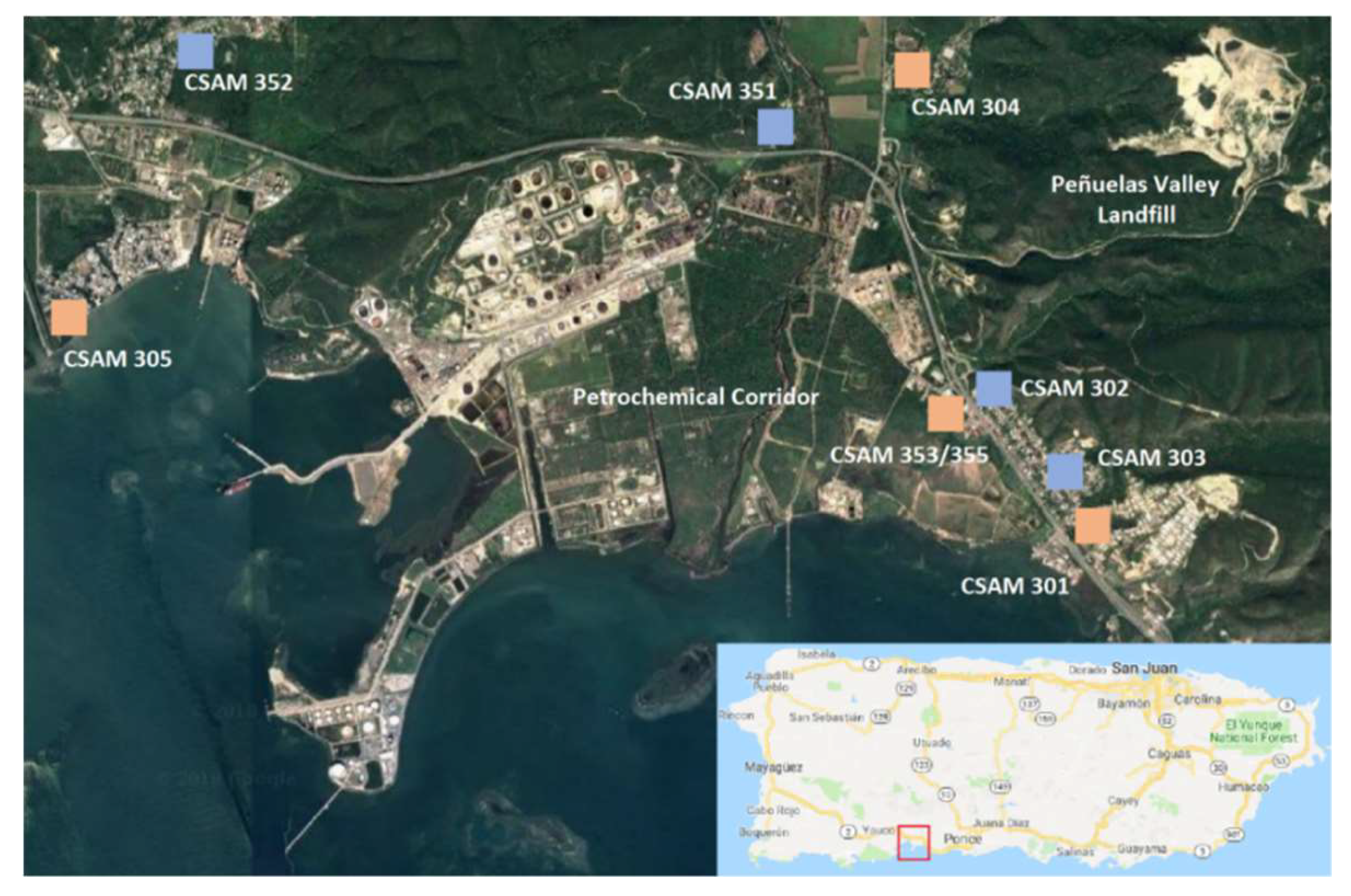
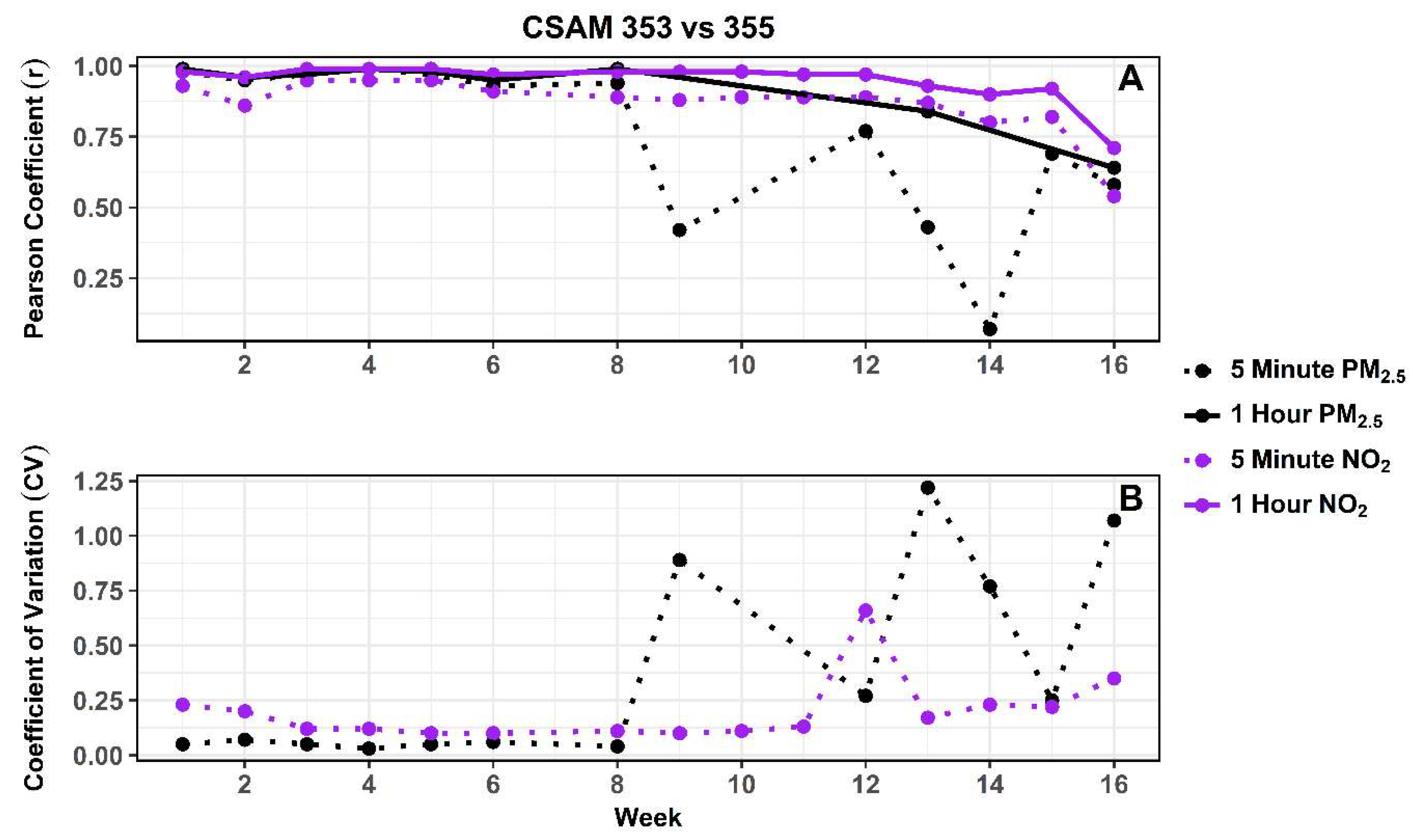
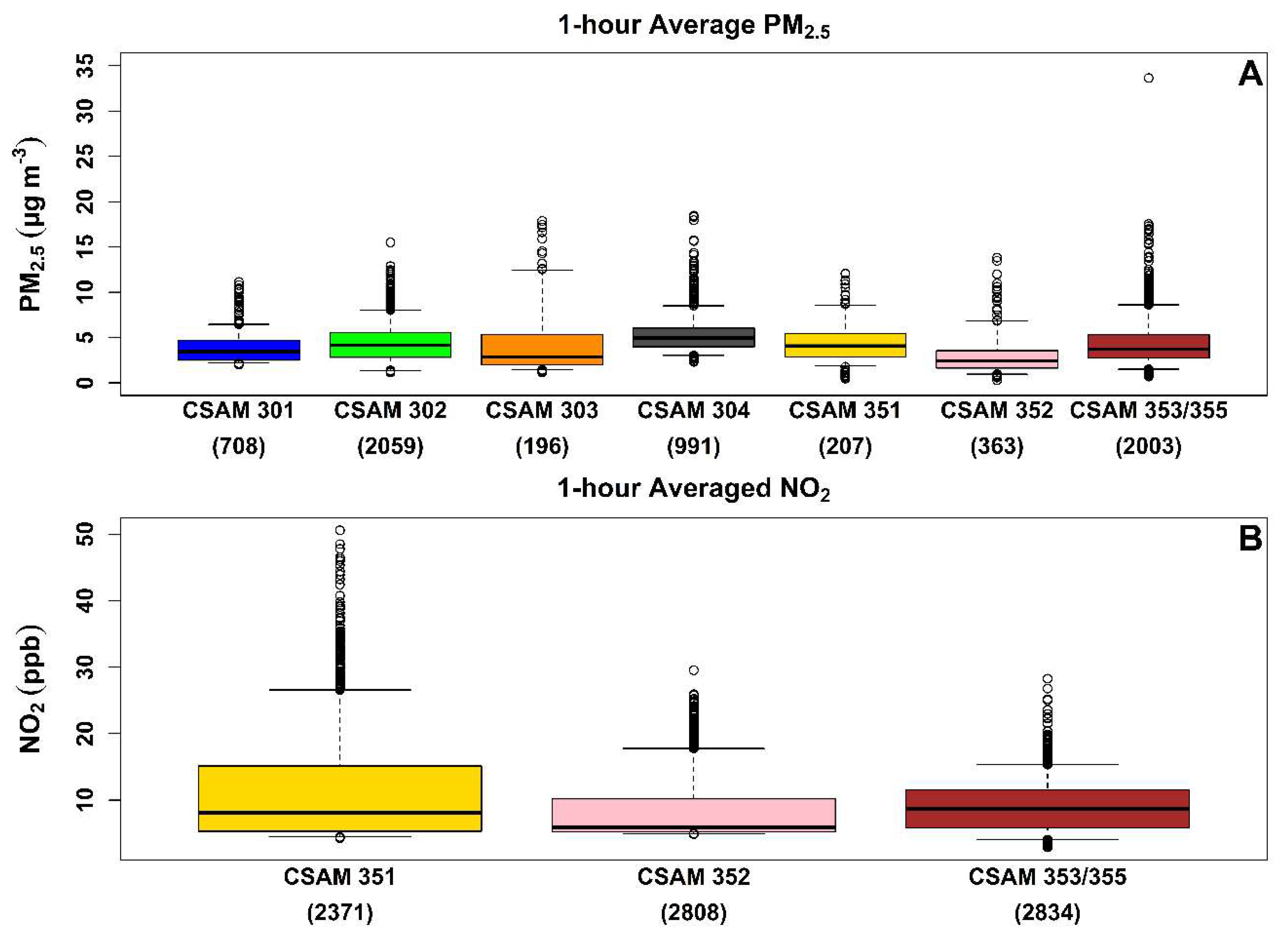
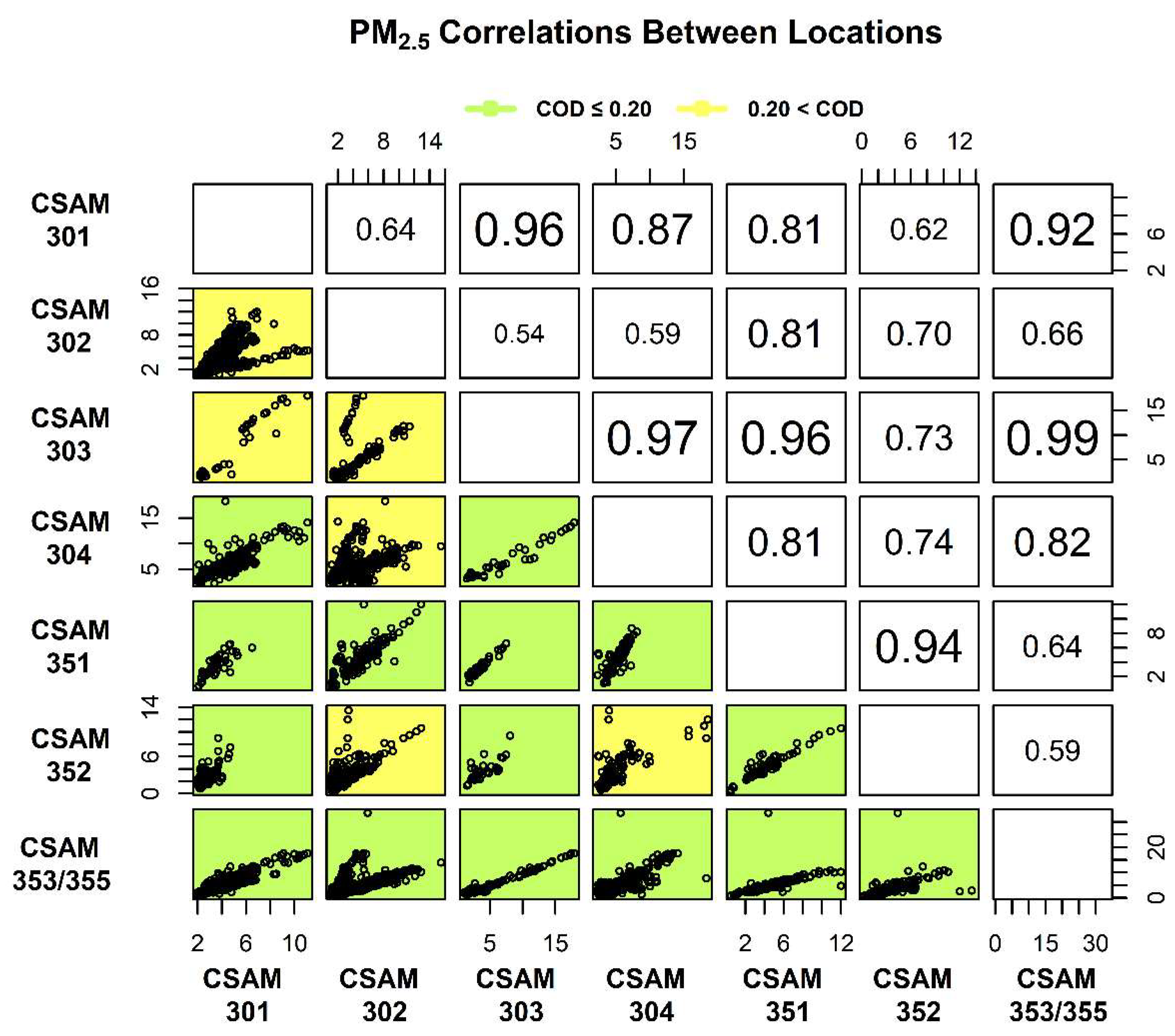
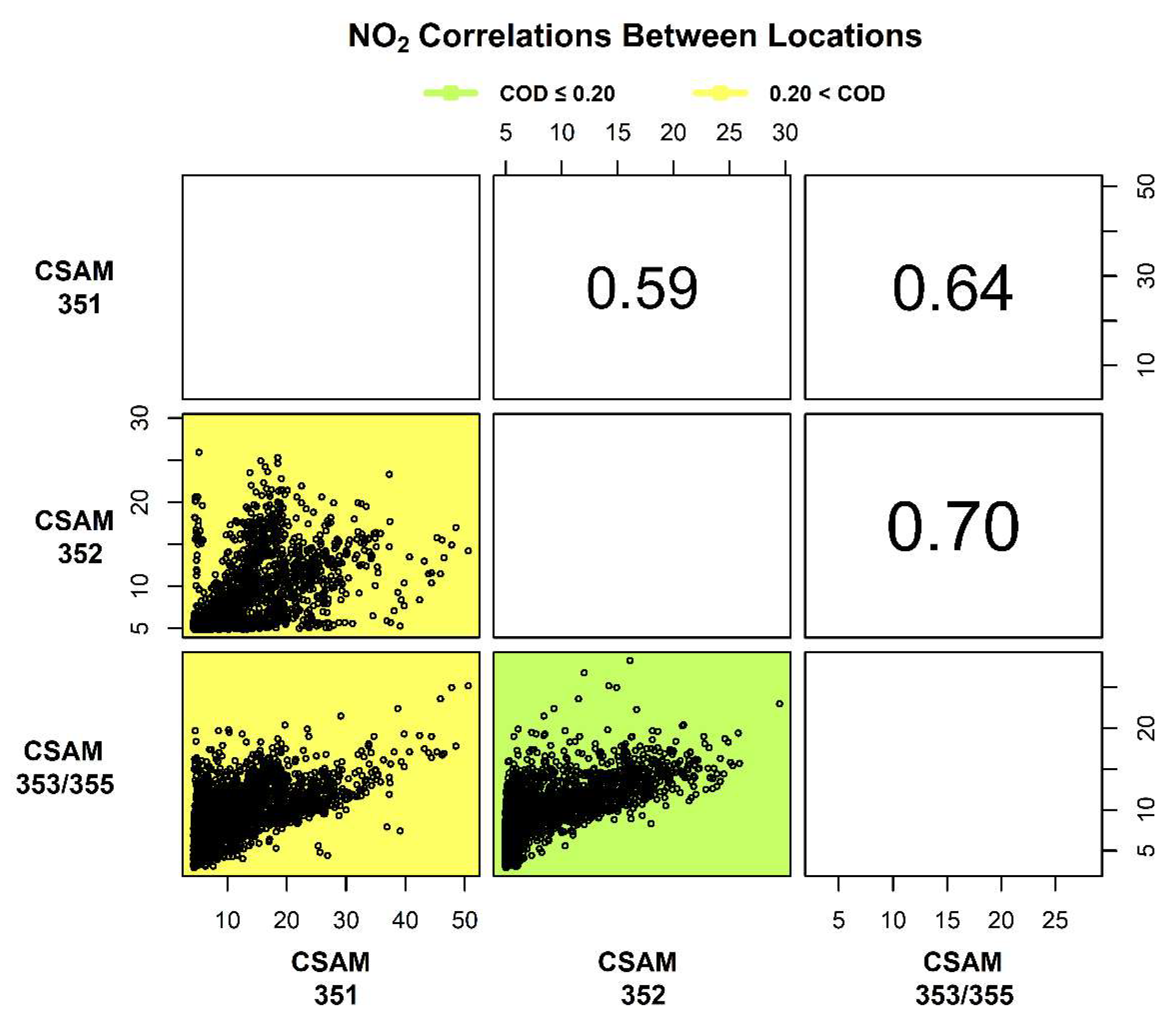
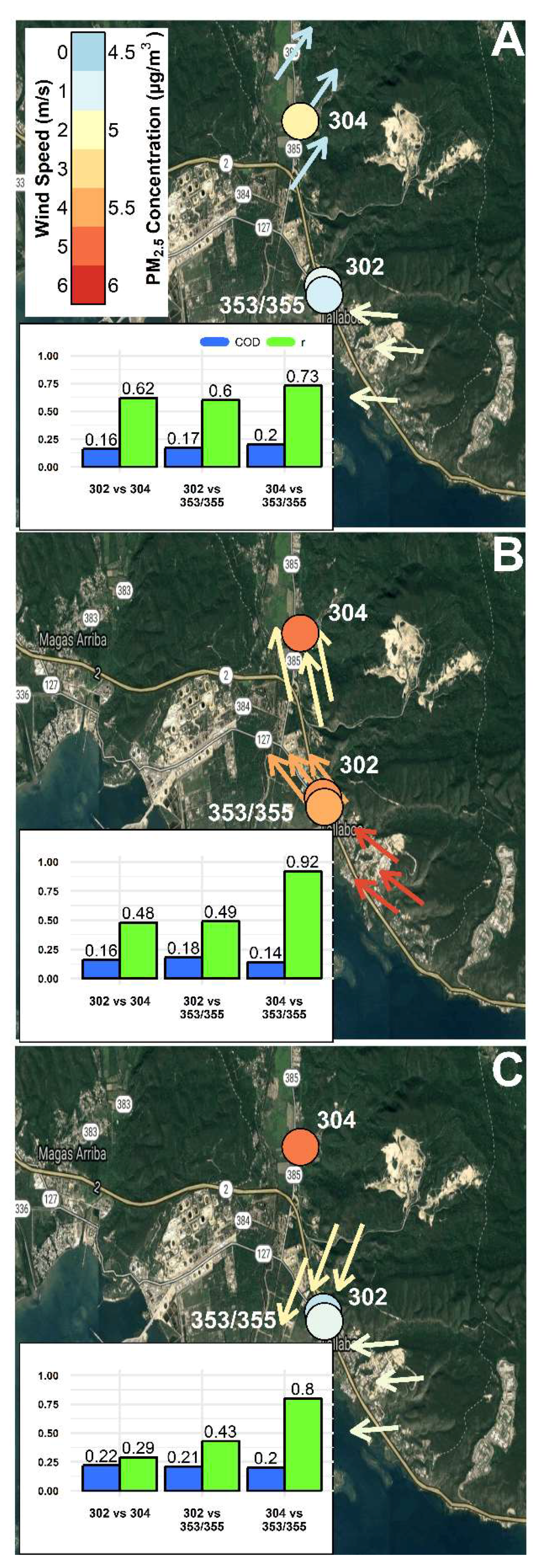
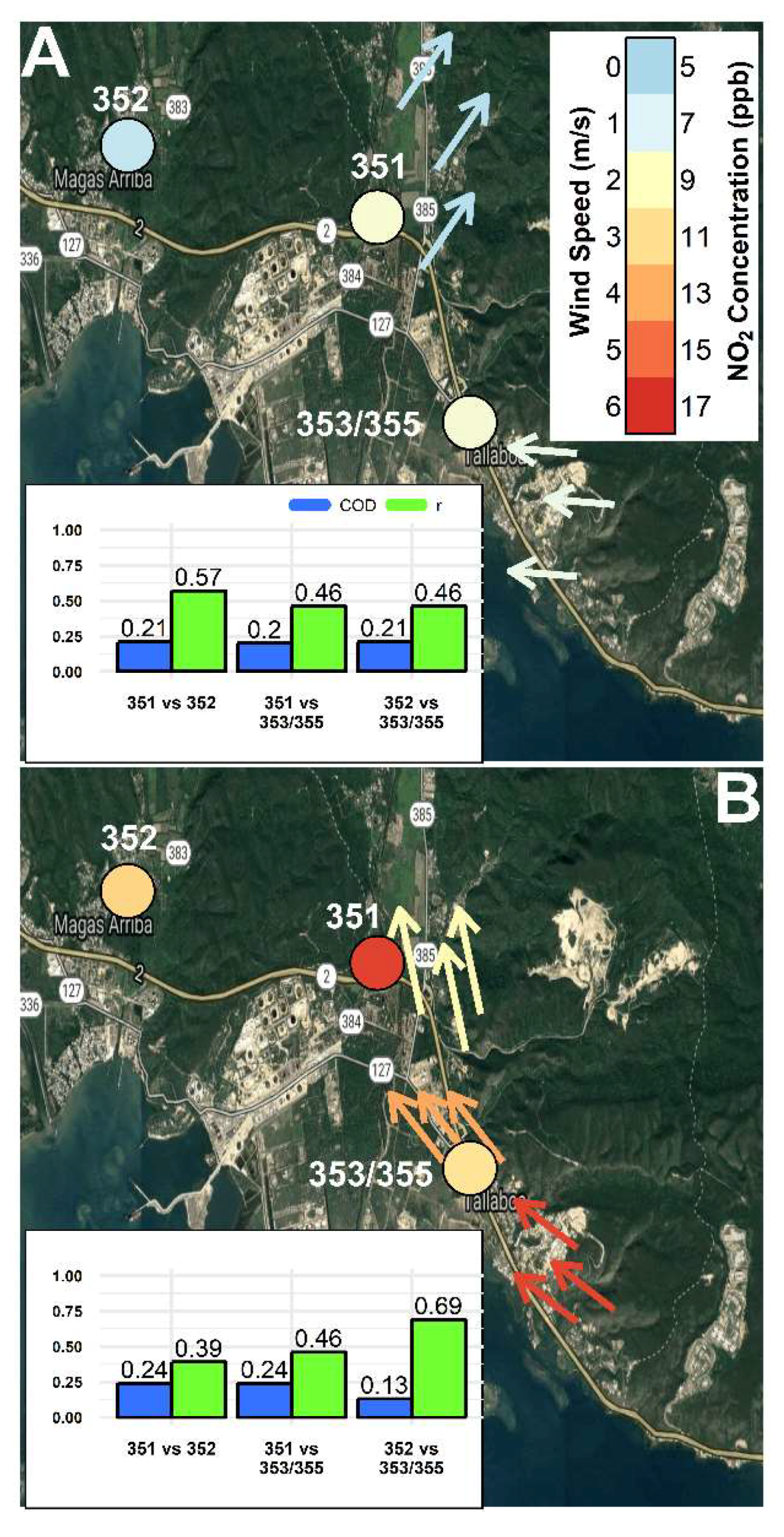
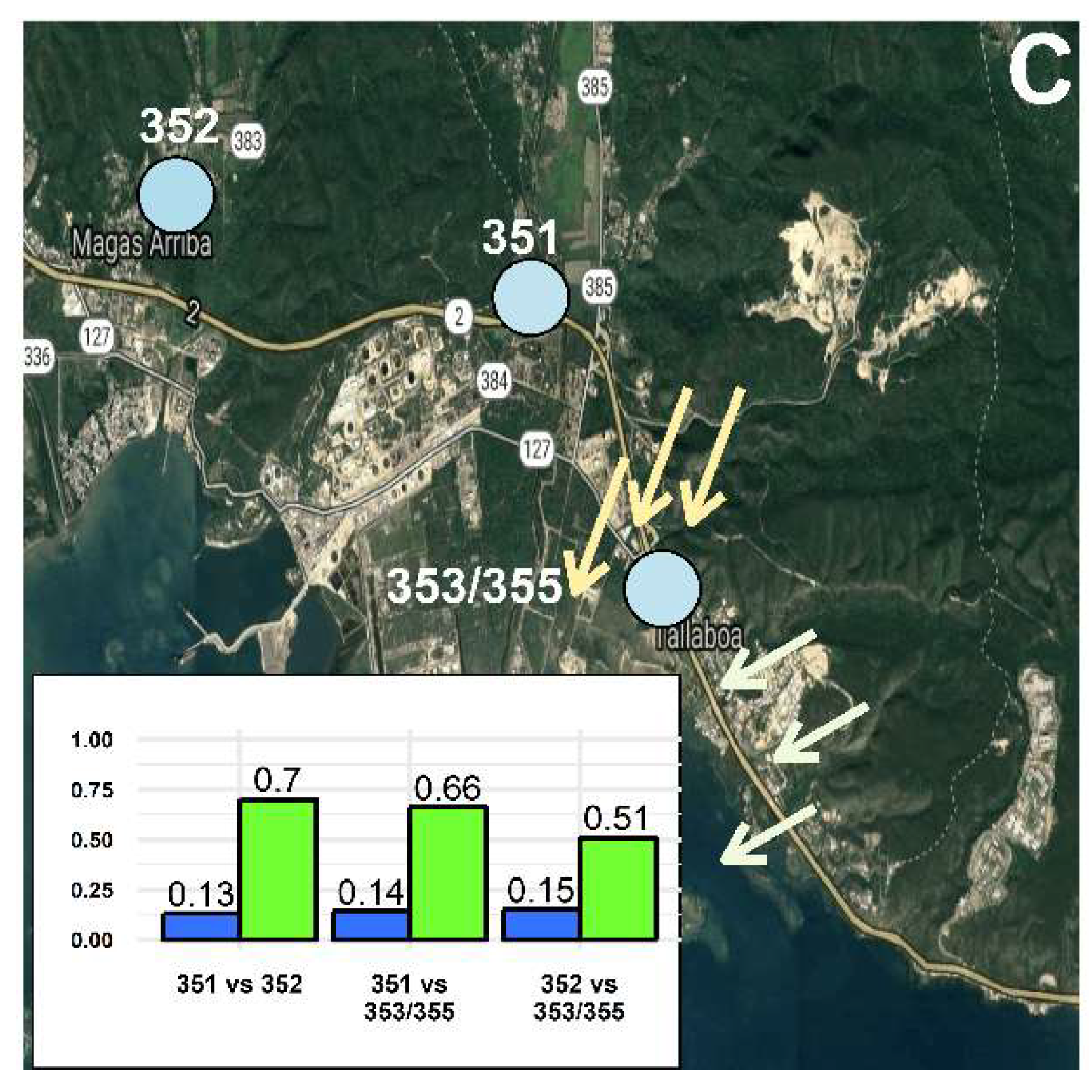
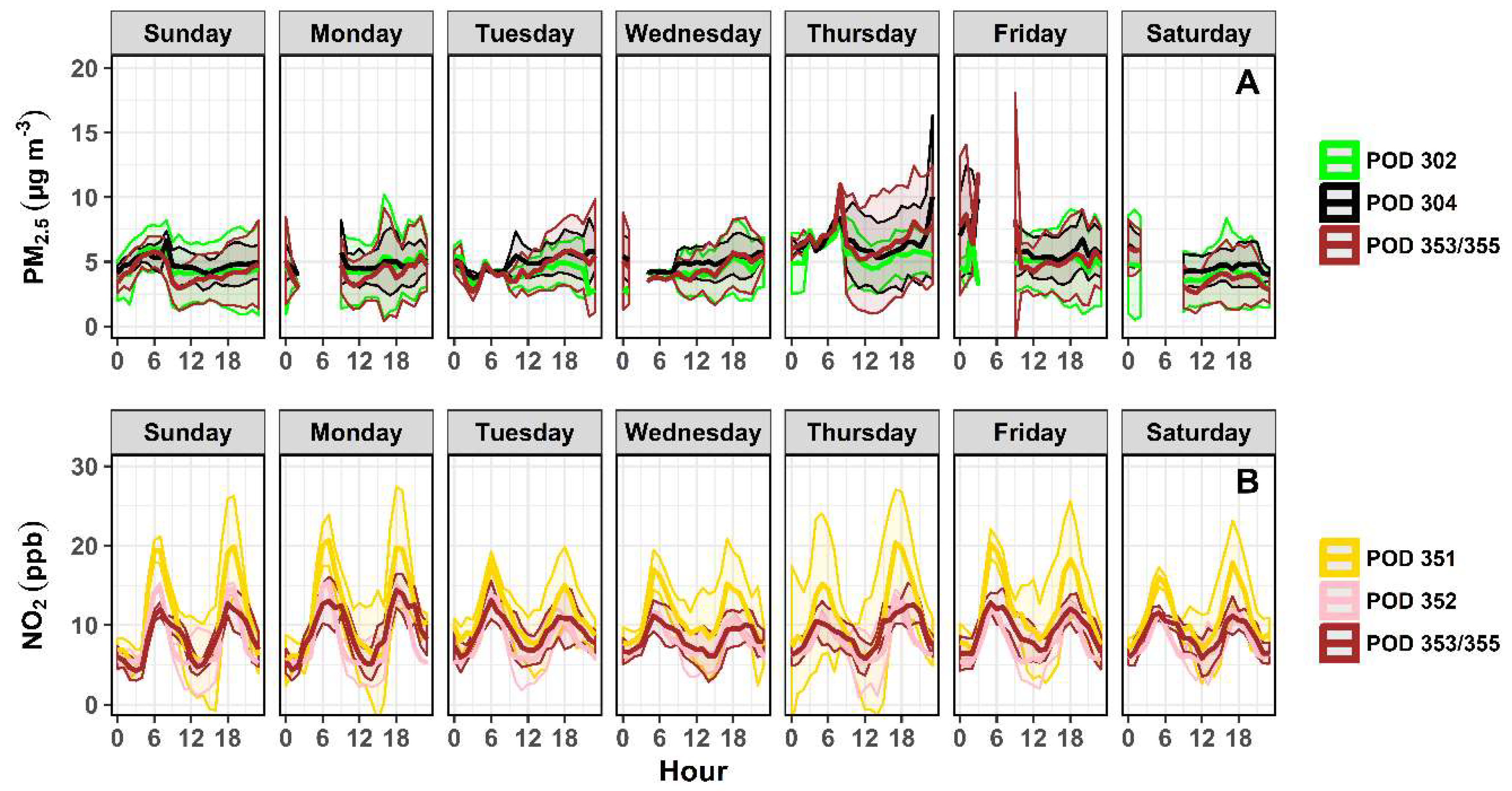
| Weather Station | Meteorological Condition | November | December | January | February |
|---|---|---|---|---|---|
| East (CSAM 301) | Temperature (°C) | 26.8 | 26.8 | 25.2 | 26.5 |
| RH (%) | 79 | 71 | 70 | 69 | |
| Wind Speed (mph) | 2.3 | 2.7 | 2.6 | 3.7 | |
| Wind Direction (°) | ESE (115.0) | ESE (115.0) | ESE (115.0) | ESE (115.0) | |
| North (CSAM 304) | Temperature (°C) | 25.5 | 25.3 | 23.9 | 25.2 |
| RH (%) | 87 | 80 | 78 | 76 | |
| Wind Speed (mph) | 0.5 | 0.7 | 0.8 | 1.4 | |
| Wind Direction (°) | E (93.5) | SE (138.5) | SSE (161.0) | SSE (161.0) | |
| South (CSAM 353/355) | Temperature (°C) | 26.0 | 26.4 | 25.1 | 26.2 |
| RH (%) | 79 | 73 | 72 | 71 | |
| Wind Speed (mph) | 1.8 | 2.3 | 2.3 | 3.0 | |
| Wind Direction (°) | E (79.7) | ESE (111.8) | ESE (111.8) | SE (127.8) | |
| West (CSAM 305) | Temperature (°C) | UN | 24.8 | 23.8 | 24.8 |
| RH (%) | UN | 80 | 79 | 80 | |
| Wind Speed (mph) | UN | 1.9 | 1.5 | 3.5 | |
| Wind Direction (°) | UN | 127.0 (SE) | 127.0 (SE) | 127.0 (SE) |
© 2018 by the authors. Licensee MDPI, Basel, Switzerland. This article is an open access article distributed under the terms and conditions of the Creative Commons Attribution (CC BY) license (http://creativecommons.org/licenses/by/4.0/).
Share and Cite
Reece, S.; Williams, R.; Colón, M.; Southgate, D.; Huertas, E.; O’Shea, M.; Iglesias, A.; Sheridan, P. Spatial-Temporal Analysis of PM2.5 and NO2 Concentrations Collected Using Low-Cost Sensors in Peñuelas, Puerto Rico. Sensors 2018, 18, 4314. https://doi.org/10.3390/s18124314
Reece S, Williams R, Colón M, Southgate D, Huertas E, O’Shea M, Iglesias A, Sheridan P. Spatial-Temporal Analysis of PM2.5 and NO2 Concentrations Collected Using Low-Cost Sensors in Peñuelas, Puerto Rico. Sensors. 2018; 18(12):4314. https://doi.org/10.3390/s18124314
Chicago/Turabian StyleReece, Stephen, Ron Williams, Maribel Colón, David Southgate, Evelyn Huertas, Marie O’Shea, Ariel Iglesias, and Patricia Sheridan. 2018. "Spatial-Temporal Analysis of PM2.5 and NO2 Concentrations Collected Using Low-Cost Sensors in Peñuelas, Puerto Rico" Sensors 18, no. 12: 4314. https://doi.org/10.3390/s18124314
APA StyleReece, S., Williams, R., Colón, M., Southgate, D., Huertas, E., O’Shea, M., Iglesias, A., & Sheridan, P. (2018). Spatial-Temporal Analysis of PM2.5 and NO2 Concentrations Collected Using Low-Cost Sensors in Peñuelas, Puerto Rico. Sensors, 18(12), 4314. https://doi.org/10.3390/s18124314




